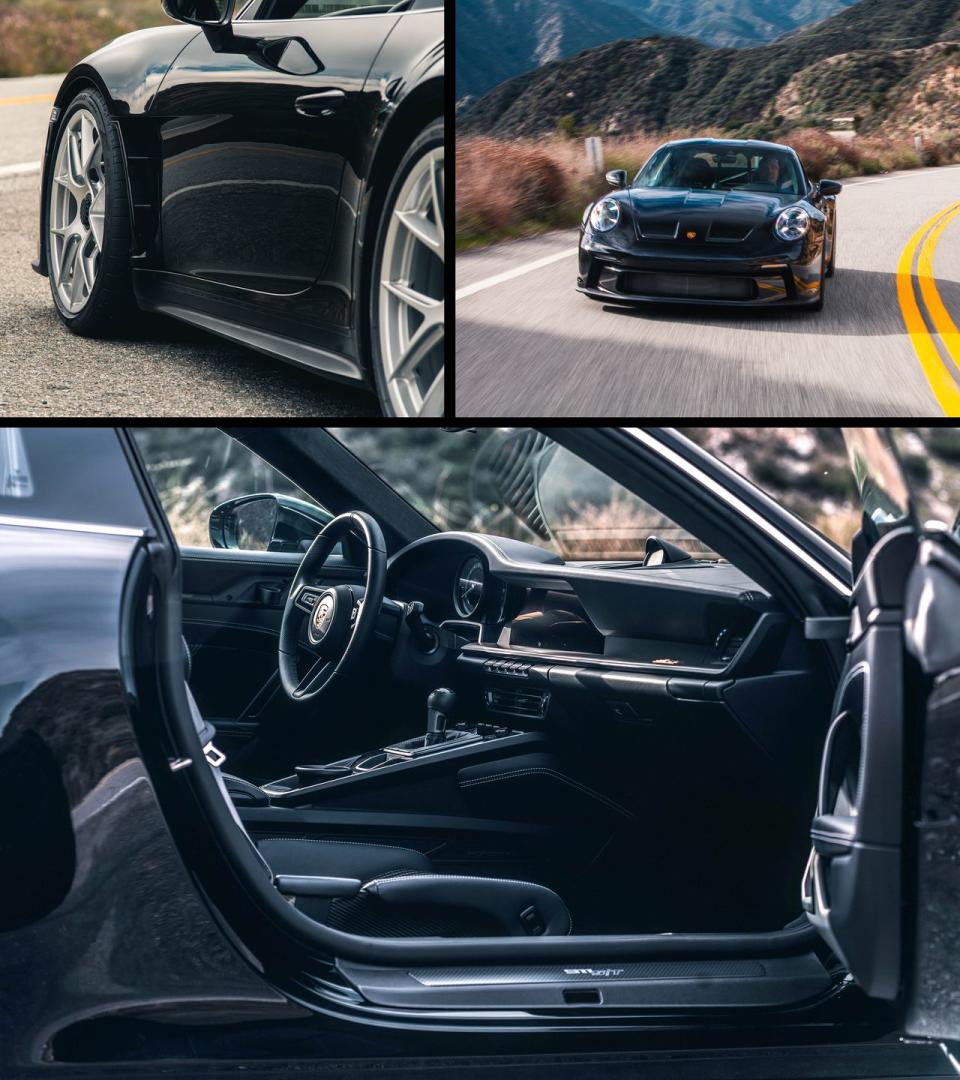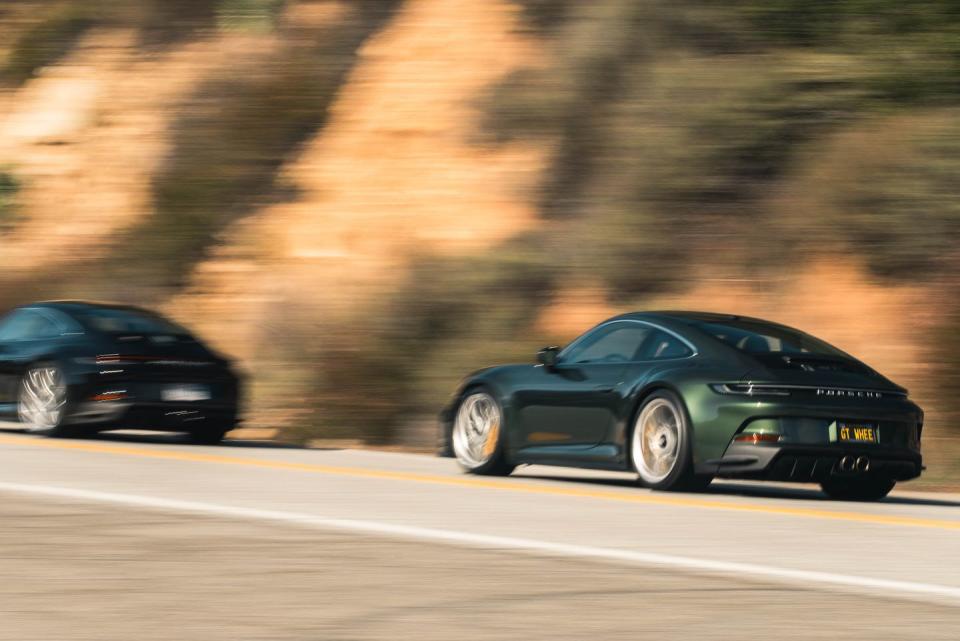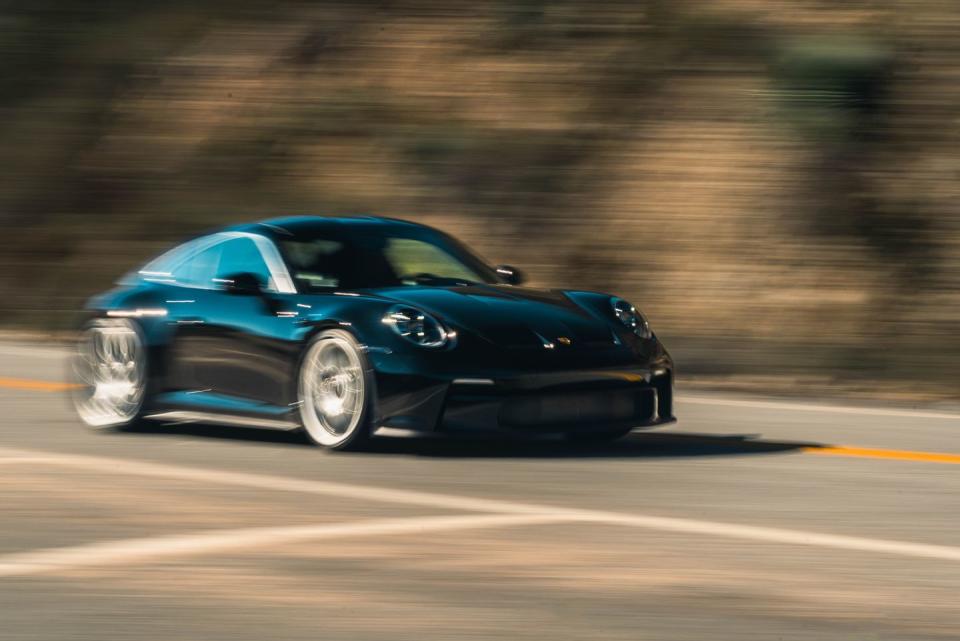Porsche 911 GT3 Touring vs. Porsche 911 S/T: Road Test


“Be honest. It’s basically the same car,” the Instagram comment read. Hard to blame the commenter here, as, particularly in deep black, the 911 S/T does look the spitting image of the GT3 Touring from which it was birthed, which, to the untrained eye, looks basically the same as all the other 911s in production today, and, to be honest, most of the ones before them, too.
The GT3 Touring, or, as it is technically called, “GT3 with Touring Package,” (more on that later) was last year’s “if you know, you know” darling. A GT3 with some chrome window trim, a wing delete, and basically nothing more, the Touring represents everything Porschephiles love about the brand. You got a racing-bred engine that revs to the sky shoved inside a low-key-looking body devoid of wings, scoops, or flairs. It has an available short-throw six-speed transmission, and for no real reason, production numbers well underneath the potential demand, creating one of the industry’s only short-term appreciating asset classes for those with access to allocations.
Throw in endlessly customizable colors and trims through the Exclusive Manufaktur program - tens of thousands of possible unique specifications, and the rest of the math sorts itself out right away.

If you don’t know cars, it’s just another 911. If you do know cars, or even better, if you’ve spent time wheeling one, you understand why people are willing to pay tens, if not hundreds, of thousands of dollars over MSRP to get a GT3 Touring. Ferrari, Lamborghini, Audi, and Aston Martin have all but abandoned manual transmissions and natural aspiration, but not Porsche. If you want a brand new exotic in which to row your own, Porsche is the last, best game in town.
The irony is, that for all its talents, the GT3 Touring is not particularly adept at... touring.
Sure, you can get the comfort seats and lots of leather, such as my friend Geoff has optioned in his spectacular Oak Green over Cognac example you see in these photos. But as I noted in my review of the car for The Smoking Tire back in 2022, the chassis setup, while fantastically sharp in the corners, is nervous on the highway. It bucks and darts at relatively slight imperfections in the road surface -- what I frequently refer to as a “Two-handed driving experience.”

I’m not the only one to note this. Journalists and owners with experience across Porsche’s spectrum have made similar comments. Zuffenhausen has heard them. Many owners, including my automotive mentor, Top Gear’s Chris Harris, eschewed the 992 GT3 Touring for the previous generation, which is more livable as a road car.
That all leads us to the new 911 S/T, this year’s “if you know, you know” darling. It starts at around $100,000 more than the GT3 Touring, it’s only subtly different from the outside, and it packs the same fundamental 4.0-liter / six-speed powertrain, with only 16 more horsepower than the Touring. Yes, it’s from the GT3 RS if you want to nitpick, but 16 horsepower isn’t many. One cannot be surprised at any amount of healthy skepticism towards this car. At first glance, it seems like a shameless money-printing machine for both Porsche and its allocation class.
Nevertheless, then-Road Test Editor Brian Silvestro went on the launch and came back saying the S/T is “The Greatest Road Car I’ve Ever Driven.” My co-host for The Smoking Tire and R&T contributor Zack Klapman was also on the first-drive program in Italy and texted me from 10 time zones away saying, “Call your dealer and see if you can get one of these. It is that good.” I did, and I can’t.

I trust Brian and Zack’s opinions, and you should too. They are both very good at their jobs. But what I really wanted was to try one for myself, so I arranged for a few days with the S/T in California. I wasn't going to just to run up the hill, but also to live with it as a car in town and on the highway. Porsche wants this to be a road car, so I’d daily it. For science, I got my good friend Geoff to bring his GT3 Touring out for a back-to-back canyon drive.
But first, rewind the tape to this past summer. I was in Germany on the international media drive for the new Spyder RS. (That car is great, and you should read R&T's review and watch my video to see and hear for yourself.) As a bonus, Porsche took some very special cars out of their museum for us to play with. One in particular applies today: the 1985 Carrera Clubsport Prototype. (You can read about it in here.) On the outside, this little white thing looks like any other whale-tail-equipped Carrera. I wasn’t even particularly interested in driving it. I should have been. This was by far the best, quickest G-Body car I’ve ever driven, south of the RUF CTR “Yellowbird.” It was raw, responsive, and felt like it made about 325 horsepower from its naturally-aspirated engine. I asked what had been done to make the car so quick. “To the engine? Nothing. Completely stock 240 horsepower 3.2. Just a light flywheel and a motorsport short-shifter. But it weighs 1,050 kilos (2,310 lbs) because it has a carbon kevlar body, lightweight glass, no radio or A/C, and a full cloth interior with no rear seat.”
I was properly shocked. It made sense from an engineering perspective -- weight had been removed not just en masse (no pun intended) but in such a targeted way, that it could really only have been achieved at the factory level. The end result was substantially more than the sum of its parts. No one does this like Porsche, and it’s the kind of thing Seinfeld’s crew goes on and on about at coffee on Sundays because they own the really good stuff and the rest of us just go “but it’s really the same car, isn’t it?” No, it’s not. Not at all. I didn’t know it at the time, but this was an unforgettable primer for the S/T.

Starting with a GT3, as you may have read in Brian’s piece, the S/T gets the following: carbon doors and “double bubble” roof from the RS, as well as carbon front fenders to match. It gets a new rear decklid and a powered wing that rises at 70 mph rather than 55 thanks to a small Gurney flap. It has standard ceramic brakes and magnesium wheels from the RS, carbon fiber sway bars from the RS, and a final drive ratio shortened from 3.96:1 in the GT3 to 4.3:1 here. The steering ratio has been slowed compared to the GT3, and rear-steer has been eliminated. Though the suspension components are identical to the GT3’s, the electronic shocks have been painstakingly reprogrammed. That’s not really many changes, and it certainly doesn’t sound like $100,000 more than the GT3. But remember the Carrera Clubsport. The S/T weighs 84 pounds less than the lightest possible GT3 Touring - a claimed 3,056 pounds. That’s almost 100 pounds lighter than my 718 Spyder, in a 992 chassis! And that weight reduction is targeted, not just pulled out from wherever like you might do while stripping a Fox Body to race in Lucky Dog.
The first thing you, or anyone else, notices once starting up the S/T is the flywheel, which has been lightened by an astonishing 23 pounds compared to the GT3. On startup, give the engine a few blips in neutral, and it’s unmissable. The S/T’s engine has less rotational inertia than any engine I’ve ever felt in any car. The transmission, bereft of any rubber mounts, chatters and clatters away behind you through the bulkhead. The whole vibe is more like a Ducati Panigale than a normal sports car. One might expect that, were this a series production model and not a niche-enthusiasts special, Service Advisors might be fielding lots of calls from clients thinking their car is broken.
Two years ago, I found the GT3’s manual transmission to be possibly the most “stallable” car on sale today. Typically a manual transmission car with a normal flywheel will have better clutch engagement from a stop than one with a lightened flywheel. The flywheel provides rotational inertia that keeps the engine running at very low throttle, such as taking off from a traffic light or stop sight. The GT3 already had a lighter flywheel than the previous 991.2 generation car, which revs up quicker, but made it harder to smoothly take off. The S/T, as I said, is lighter still. Nevertheless, I found it to be a bit easier to drive the S/T than the GT3 in traffic, provided you were willing to feather the pedal and ride the clutch a bit more.

Having said that, my 5,000-mile S/T tester (5,000 press miles is like 25,000 owner miles) was already showing signs of a worn clutch. I suspect this is due to a combination of people getting used to this technique, magazine instrumented testing, and every single person who drove this particular car being of a mindset that this is the one and only time in their life they may ever get to try one. I forgive them all for their clutch-smoking sins.
You notice the ride improvements right away. The word I kept coming back to, over and over, is “settled.” It’s firm, no doubt. This is a lightweight sports car not a Bentley, and it isn’t pretending to be. At no point in urban or highway driving, though, was the S/T anything but compliant, relaxed, and easy. Though the short final drive means the six is spinning at over 3,000 RPM at most highway speeds, the turbine smoothness of the mill means just a bit more fuel is burned, not that the car feels strained, strung, or working any harder than if it were any other 911. I’m told Porsche engineers spent two years working on the fine tuning of the shocks and the set up balancing the steering ratio with the elimination of rear steer, and that time wasn’t wasted. I’d rather take a road trip in the ST, even without sound insulation, than any other GT car in recent memory.
With only just over 3,000 lbs to lug around, 518 horsepower is plenty. It doesn’t take much room to double or triple the speed limit in this thing, and in the binary “Is it fast?” measurement system, yeah. It’s real fast. It’s as fast as a road going car would ever need to be for any real justifiable reason, particularly one with a manual gearbox. It accelerates and brakes at exactly the same pace as my brain is capable of upshifting or downshifting a manual transmission car.

Speaking of shifting, let's go back to the light flywheel. Like I said, the engine has virtually no rotational inertia whatsoever. Think liter bike. You cannot “cruise” through upshifts in the traditional “lift off the throttle” manner. You need to either shift gears quickly all the time to catch the engine, or feather the throttle in between gears to prevent the revs from dropping too low. Being a 992, automatic rev-matching is standard, but I left it off because where’s the fun in that?
In order to really feel the nuanced difference and decide if the S/T was game over for the 992, I met my good friend Geoff on the hill with his GT3 Touring for our back-to-back canyon time. As repayment, I promised him a quick go in the S/T, to get his thoughts as an owner.
I had driven for three days and about 200 miles in the S/T when I climbed into the Touring. First thought? Cognac-colored comfort-spec seats rule. Porsche’s buckets are as good as they come, but for “Touring” I’m all-in on the comfort seats. Second thought: sound deadening works. The Touring feels well insulated and refined compared to the raw gear train noises from the S/T.

You don’t immediately notice the difference in the short final drive going back-and-forth between the two cars. It's only apparent if you’re noticing the actual speeds at which you hit redline, or once cruising on the highway.
What you do notice is how much sharper the Touring is in back-and-forth switchbacks and hairpins. Turns out a quicker steering ratio paired with rear steer means you can do more with less - turning sharper into each corner with less steering input of the wheel. It gave me something to think about but once I returned behind the wheel of the S/T, I didn’t miss it, and the S/T still took hairpins just as effectively, even if requiring a few more degrees of input. One interesting note on the lack of rear-steer is that the S/T is the first 992 I’ve ever driven without it. All the Porsche press cars, even the ones where rear-steer isn’t standard, come fitted with it as an option. I thought I would miss rear-steer in the S/T, either in the handling or in the close-quarters maneuverability, and frankly, I did not.
The big one was the ride. It’s not that the GT3 Touring is bad, per se; certainly not on SoCal’s stunning Highway 39, a relatively smooth and fast canyon road high above the city. It’s that there is a noticeable increase in body motion after driving the S/T. That word I used, “settled,” about the S/T, doesn’t really apply to the Touring. It’s nervous. It's manageable, and in isolation, fine. Good, even. There’s loads of grip, yes, but also loads of grip from my hands to the steering wheel to keep the car in line. The rougher the roads, the wider the gap in ride quality and predictability between the two cars.

Back-to-back, you can tell the rear-steer and quick steering ratio, in conjunction with the shock tuning, are all doing their work to make the car handle as sharply as possible - an admirable choice for the GT3. But for the GT3 Touring? It seems like a mis-step (something that I noted in my original Touring review) that is more deeply emphasized by driving the S/T. The whole point of the Touring nomenclature should really imply that it gets the GT3 powertrain, but with a setup that’s more oriented towards street driving and road trips. But it’s actually just a GT3 without a wing. Everything else is the same. Hence “GT3 with Touring Package.”
Like, you know how there was a Subaru Legacy, and then the Legacy Outback, and then all Legacys became Outbacks, and now we have the Outback Wilderness, which those of us at R&T refer to as the “Outback Outback?” It’s like that. The 911 S/T is the GT3 Touring Touring.
Despite the extra power, despite the lighter weight, despite the fact that you can hear every rotation of the transmission and flywheel through the rear bulkhead, despite the bucket seats and the magnesium wheels, and everything else, the S/T is actually better at the activity of Touring. On the highway, even the expansion joints and aging concrete of the notorious 405 Freeway, the S/T is a one-finger affair. Gone is the darty, twitchy steering of the GT3. Gone is the bounciness from a track-ready suspension.

At the same time, the changes have made the S/T feel more raw and analog than any other Porsche on sale today, something I believe will give it a truly timeless quality. If you only ever drove air-cooled cars, skipped past Porsche’s turbocharged offerings, and got into the S/T, you will feel immediately at home. The simultaneous removal of technology and weight pays off in spades when it comes to driving engagement, much more so than I expected beforehand.
Geoff, the owner of the GT3 Touring featured here, returned from his canyon blast in the S/T saying, “Wow. That’s amazing. Such a good car. So raw. But I don’t see a scenario in which I use my car as a trade in, plus throw in an extra two or three hundred thousand dollars for one. It’s just not that different of a vibe.”
I have to agree. The S/T is definitely not the same as a GT3 Touring. It’s better. A lot better. All of Porsche’s decisions with this car have improved the GT3 Touring in every conceivable way. But unless you do not work to earn your money, it’s a nuanced difference, not multiple hundreds of thousands of dollars difference.
Frankly, the S/T’s steering rate, removal of rear-steer, and shock tuning should be the standard on the GT3 Touring. Then, all of Porsche’s light weighting efforts for the S/T, all that stuff off the RS, could be directed to an optional “Sport Licht” package for the GT3. To me, that would best optimize the use of these resources, and allow the most possible people to enjoy the sums, which are greater than their parts, of Porsche’s engineering excellence.
But that’s not what we have. Instead, just 1,963 people will get to take home an S/T, and experience the very best car that Porsche has built in quite some time. The limited production means it’s not just a great car, it’s an asset class, remaining unobtanium to enthusiasts who have to consider the cost of things before sending the wire. That group, I lament, includes people like me, as I’m not one of “the allocated.”
All I can say is if you’re one of the lucky nineteen hundred and sixty three, please drive your car. Miles are cheap on something like this. Even if they weren’t, when it’s this good, they are worth it.

A car-lover’s community for ultimate access & unrivaled experiences.JOIN NOW Hearst Owned
You Might Also Like

 Yahoo Autos
Yahoo Autos 